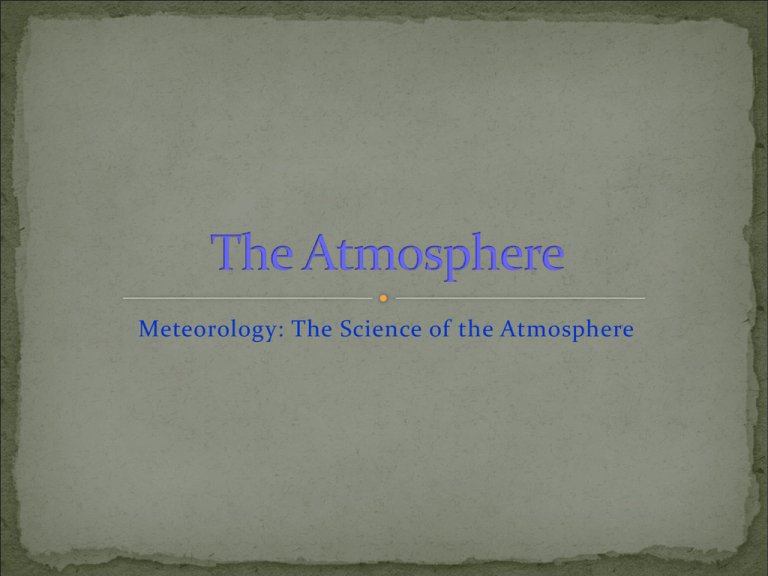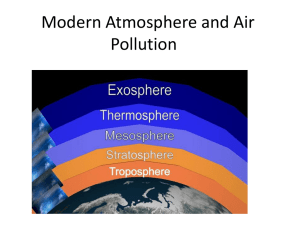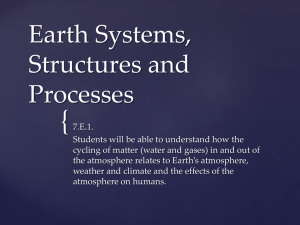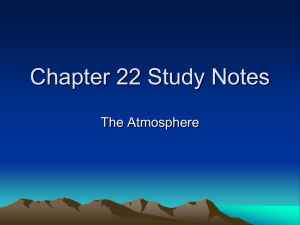The Atmosphere
advertisement

Meteorology: The Science of the Atmosphere Warm-up: Make a list of all the ways the atmosphere is different from outer space. Homework: 1- Review all notes- remember to be ready for a QUIZ at any time! *SF 5 testable questions due 9/10. Science in the News #2 due 9/12 The atmosphere: 1. What is it exactly? 2. What is its composition? First, let’s revisit OBJ 1: “Explain that Earth’s atmosphere is a mixture of particles which are made up of matter.” Air What is air? A gas(es) *Made up of particles or molecules A mixture of gases and other particles that surrounds the Earth *Other particles: solids= dust, ash, sea salt, dirt & smoke Liquids= water and gases = oxygen, carbon dioxide, nitrogen, argon and others Gas Made up of particles or molecules: *balloon Matter Anything that has mass and takes up space. THINK: solid, liquid, gas or *plasma. http://www.chem.purdu e.edu/gchelp/liquids/ character.html Because all objects are made out of molecules, it is possible to determined how tightly packed those molecules are. This is known as density. The more tightly packed the molecules of an object, liquid or gas are, the more dense we say they are. DEMO- air pressure *balloon The density of an object doesn’t change. Or does it? It shows a relationship. WHY? The density of a solid will remain the same no matter where we place the object. For a liquid, density will change only slightly. However, the density of a gas changes drastically. OTHER GASES INCLUDE: Ozone Water vapor Xanon What do you think the Earth’s atmosphere would be like if plants did not exist? Group Work: Read “How Earth’s Atmosphere Got It’s Oxygen” independently In groups answer questions 1-3 The atmosphere is made up of a mixture of atoms & molecules. Air or gases are made up of matter- they have mass and take up space. Think of the BALLOON. Density is the concentration of particles in a given space. Nitrogen is the most abundant gas in the atmosphere Earth’s atmosphere makes conditions on Earth suitable for living things. What is the atmosphere? Name at least three gases the atmosphere is composed of. Warm-up: Which gas- oxygen or nitrogen – is the major component of Earth’s air? Homework: 1- Read & take notes on pgs 3-9 do SR on pg 9. (Notes on the layers of the atmosphere.) 2Science in the News #2 due 9/12. *Look ahead on SF timeline- what is coming up!!! What is air pressure? Air pressure: Is the measure of force with which the air molecules push on a surface. *Read the article for HW. DEMO “Air Pressure” (cup of water & cardboard &/or paper towel) High pressure = high density Low pressure = low density https://www.youtube.com/watch?v=goUhGwX-xWo https://www.youtube.com/watch?v=DZX2mD4voK4 Altitude Temperature Air Pressure Density Altitude: Height of an object above Earth’s surface. What do you think happens to air molecules as they go up into the atmosphere? The atmosphere becomes less dense the higher you go away from Earth’s surface -altitude. Atmosphere has weight (pull of gravity). It is the weight of the air above which compresses the air below it to greater density. Air pressure decreases the higher up in the atmosphere you go. http://www.classzone.com/books/earth_science/terc/co ntent/visualizations/es1901/es1901page01.cfm?chapter _no=19 Classzone 1901: Pressure & Altitude 18 What is temperature? Temperature is the average energy of particles in motion. High temperature means that particles are moving very fast. Liquid water: What do you think happens when water evaporates into the atmosphere? What is density? How tightly molecules are packed within a given space. Density = Mass Volume Reminder: what is density? Think about what happens to the gas particles. Use the image on the following slide to answer the following: *Describe the differences in air pressure between points A and B. Density of Air at Two Altitudes Density At Air Level A. Density At Sea Level B. A gas will expand to fill the space it is provided. If we take a certain amount of gas out of one container and place it into another container that is twice as large the gas will expand, filling the larger container. We still have the same number of gas molecules, but now, they are filling a much larger area. Thus, the gas is half as dense as it was before. There is twice as much space between the molecules as there was in the smaller container. decreases with an increase in Air Pressure increases with Altitude Temperature Density Is affected by both altitude and temperature Aneroid measured with Barometers types Mercury An instrument to measure air pressure Aneroid Mercury 26 a.) Name 3 factors that affect air pressure. b.) Explain how temperature changes with altitude. c.) Why does it feel more humid in the summer time? Warm-up: Have out yesterday’s notes and SR from page 9. While you’re waiting for class to start complete “Layers of the Sky” (OPTION). Homework: Complete Ch. 1 Directed Reading worksheet packet- Due Monday. Science in the News #2 due 9/12 Agenda: Complete chart: column titled “Major features or characteristics”. (Use your textbook, notes, and partner to help you.) Discuss profile on textbook page 6. Begin reading through tomorrow’s lab: “Layers of the Atmosphere” Begin tonight’s homework- IF time! See page 6 of your text. Answer the following. 1. Which layer of the atmosphere is closest to Earth? 2. How does temperature change within the stratosphere? 3. Which atmospheric layer has the greatest range of temperatures? 4. Approximately how thick is the Earth’s atmosphere? 5. What is the iridescent cloud in the thermosphere as seen on page 6? 6. What is the white layer at the top of the stratosphere as seen on page 6? Things to think about. Cold air is more dense than warm air. This is an important fact for pilots to know. Why did the Wright brothers test their biplane early in the morning? Apply this logic to the following: Why do people driving jet-powered rocket cars attempt to break the landspeed record at midday on hot salt flats? Warm-up: none. Turn in SitN #2 in BIN! Homework: 1- Finish “Layers of the Atmosphere”. All Tasksdue Monday. 2- Ch. 1 packet due Monday. QUIZ on is coming! Science in the News #3 due 9/19. *FINAL SF questions are due 9/17. Notes on layers of atmosphere- take out chart. Add notes to “Major features or characteristics” “Layers of the Atmosphere” lab Tasks 1 & 2 Independent time for Tasks 3 & 4 and Chapter 1 packet The atmosphere has 4 main layers. Based on your reading what can you tell me about Earth’s atmosphere? Let’s investigate! http://bedavis.wicomico.wikispaces.net/file/view/chapter+14++Atmosphere.pdf http://bedavis.wicomico.wikispaces.net/file/view/chapter+14++Atmosphere.pdf http://bedavis.wicomico.wikispaces.net/file/view/chapter+14++Atmosphere.pdf http://bedavis.wicomico.wikispaces.net/file/view/chapter+14++Atmosphere.pdf Temperature is the average energy of particles in motion. High temperature means that particles are moving very fast. Heat is the transfer of energy between objects. In order to transfer energy, particles MUST touch. See textbook page 8 http://bedavis.wicomico.wikispaces.net/file/view/chapter+14++Atmosphere.pdf Upper part of mesosphere & lower part of thermosphere Nitrogen & Oxygen atoms absorb harmful solar rays (like gamma rays, x-rays) Causes gas particles to become electrically charged (ions) And thus… 44 http://bedavis.wicomico.wikispaces.net/file/view/chapter+14++Atmosphere.pdf http://bedavis.wicomico.wikispaces.net/file/view/chapter+14++Atmosphere.pdf Last layer Sits above Thermosphere Border between Earth’s atmosphere and space Has no “end” . . . just goes into space Region where atoms and molecules escape into space 47 Group work: Complete tasks 1 & 2 in groups. Task 1: Create a temperature profile of the atmosphere. See textbook page 6. Task 2: Graph analysis. See textbook page 6. Task 3: Comparing the Layers of the Atmosphere Task 4: Summary Questions 1-4 Do NOT answer question # 5. Can you anyone name the four major layers of the atmosphere? How can the thermosphere have high temperatures but not feel hot? What are the other three layers we discussed? Describe them. Warm-up: Turn in Ch. 1 Self Directed packet for section 1 Homework: 1- Read pages 10 – 13. Take notes on “terms to learn” (radiation, conduction, convection, greenhouse effect, and global warming). 2- “Layers of the Atmosphere” lab due tomorrow. 3- Science in the News #3 due 9/19 Finish notes from yesterday QUIZ Time to finish “Layers of Atmosphere” lab After completing Task 1 on “Layers of the Atmosphere” what does this graph remind you of? What is the difference between this graph and a profile of Earth’s atmosphere? What is the difference between heat and temperature? Warm-up: Suppose that you will be vacationing in two unique spots- the Sahara Desert and the Antarctic ice sheet. Decide whether white or black clothing would be best for each location. Explain your choices. Homework: 1- Answer Section Review Question on textbook page 13. 2- Begin working on Ch.1, Sect. 2 Directed Reading Worksheet. 3- Science in the News #3 due 9/19. Quiz Continue Task#2 on “Layers of the Atmosphere” Group Activity: Conduction, convection, radiation. You will be put into groups. Each group will be assigned 1 of the ways energy is transferred in the atmosphere. Turn to page 10 & find your assigned term. With your group, determine how you will demonstrate that term using pictures or materials found at home or in the classroom. Each group will present their demonstration to the class. Presentations! Answer the following: 1. Describe three (3) things that can happen to energy when it reaches the Earth’s atmosphere. 2. How does the process of convection rely on conduction? 1. 2. 3. 4. 5. What are the two main gases in Earth’s atmosphere? What is atmospheric pressure? Name the layers of the atmosphere, starting with the one closest to Earth (List ONLY the main 4.) In which layer is the ozone layer located? Why is it important to Earth? What is the difference between heat and temperature? 1. 2. 3. 4. 5. What are the two main gases in Earth’s atmosphere? What is atmospheric pressure? Name the layers of the atmosphere, starting with the one closest to Earth (List ONLY the main 4.) In which layer is the ozone layer located? Why is it important to Earth? What is the difference between heat and temperature? Warm-up: Using the terms conduction, convection, and radiation, how is energy transferred throughout the atmosphere? Have out SR from page 13. Be ready to check it! TURN in FINAL SF question in SCIENCE BIN! Homework: Begin/ continue Ch.1, Sect. 2 Directed Reading Worksheet. Science in the News #3 due 9/19. Continue yesterday’s group work. Presentations Notes Read through Water Coloration lab Begin homework You will be put into groups. Each group will be assigned 1 of the ways energy is transferred in the atmosphere. Turn to page 10 & find your assigned term. With your group, determine how you will demonstrate that term using pictures or materials found at home or in the classroom. Each group will present their demonstration to the class. 61 Transfer of energy through electromagnetic waves The Earth receives 2 billionths of sun’s energy!! Energy is absorbed by a surface--> surface heats up Transfer of thermal energy from one material to another by direct contact Transfer of thermal energy by the circulation or movement of a liquid or gas. Cool air sinks and warm air rises, thus circulating in a continual process. DENSITY!! Hot air is less dense than cold air Cold air is more dense than hot air Revisit the following article. How is energy transferred throughout the atmosphere? 65 Warm-up: none. Have out SR from page 13. Be ready to check it! Homework: Continue Ch.1, Sect. 2 Directed Reading Packet (Start reading text pages 14-25 so you can complete Sections 3 and 4 of your packet). Science in the News #3 due 9/19. Warm-up: Time to meet in your groups. (20 minutes!) TURN in SitN #3 in SCIENCE BIN! Homework: Read and take notes on textbook pages 1415. Begin working on Section 3 of your Directed Reading packet (WHOLE packet due Wednesday). Science in the News #4 due 9/26. Time to work in your groups- Presentations POSTPONED UNTIL MONDAY!! Be ready to present first thing Monday afternoon!! Begin reading/taking notes on text pages 14-15. You may begin working on Section 3 in your Directed Reading packet. What is a convection current? How does a greenhouse stay warm? Explain. Warm-up: Presentations! Homework: Continue working on Ch. 1, Sect. 3 Directed Reading packet- entire packet due Wednesday. Science in the News #4 due 9/26. *QUIZ on Friday. Finish demos/ presentations Begin notes on radiation, conduction, & convection (see previous slides: #61-64) Notes on the greenhouse effect and global warming The atmosphere’s trapping of Earth’s thermal energy 50% of radiation that enters the atmosphere is absorbed Carbon dioxide & water vapor stop some of the energy from escaping back into space by absorbing and reradiating it Earth's most abundant greenhouse gases (in order) are: ■ water vapor ■ carbon dioxide ■ atmospheric methane ■ nitrous oxide ■ ozone ■ chlorofluorocarbons http://www.classzone.com/books/earth_science/terc/ content/investigations/esu501/esu501page01.cfm Conclusion What is the greenhouse effect? What specific gases that increase it? Warm-up: A metal spoon left in a bowl of hot soup feels hot. Which process-radiation, conduction, or convection- is mainly responsible for heating the spoon? Homework: 1- Greenhouse Effect webquest is due TBA (possibly Monday) 2- Science in the News #4 due 9/26. *QUIZ on Friday. 3- Bibliography of your text book (go to www.easybib.com) Continue greenhouse effect and global warming. Read designated parts of NASA Facts article “Global Warming” Greenhouse effect webquest Conclusion Why is global warming good for us? Why is global warming bad for us? Warm-up: none. Agenda: Greenhouse Effect Webquest (answer questions 1-9) Homework: 1- Greenhouse Effect Webquest is due on Friday! 2-Science in the News #4 due 9/26. *QUIZ on Friday. Warm-up: What causes wind? TURN in Science in the News #4 Homework: 1- Greenhouse Effect webquest is due on Tuesday. Reread text pages 14-15. 2- Science in the News #5 due 10/10. *SF DRAFT Bibliography due 10/1. QUIZ#1 on OBJECTIVES 1-6. Demo: hot plate and container with ice QuickLab: page 16 “Full of ‘Hot Air’” Notes: What is wind? Pressure Belts Coriolis Effect “The wind does blow from high to low” What does this mean? Which area represents low pressure? High pressure? Hypothesize: What do you think will happen and why? Try it at home! What process does this activity model? What do you think will happen if you fill the small bottle with cold water instead? What is wind? Moving air How is wind created? Created by differences in air pressure. 83 Warm Air rises over the equator _____ Pressure over the equator Warm air begins to cool and sinks at around 30 degrees north and 30 degrees south _______ Pressure over 30N and 30S Cool air begins to warm and rise at 60 N and 60 S _________ Pressure over 60 N and 60 S Convection Cells The curving of moving objects due to Earth’s rotation Winds curve to the right from the equator in the Northern Hemisphere Winds curve to the left from the equator in the Southern Hemisphere 1. What causes the Coriolis effect? 2. View the animation ES1905 How does the Coriolis effect alter wind direction? Conclusion What causes wind? How does the Coriolis Effect affect wind movement? Land & Water Lab intro 86 Warm-up: Describe the movement of air pressure belts. Homework: Reread pages 16-17. *SF DRAFT Bibliography due 10/1. Science in the News #5 due 10/10. Continue notes- see previous day (Slides #82-85) Air pressure website Demo?! Conclusion- see previous day Warm-up: Name the 6 types of wind. Pick one and describe it. Homework: Reread pages 18-19; Study! *SF DRAFT Bibliography due 10/1. Science in the News #5 due 10/10. 1. OPTION: Pop quiz- open note book? 2. “Why air moves” 3. Looking at a map 4. Types of wind- Global (Notes) 90 Recap: You tell me. Examples http://www.usatoday.com/weather/fronts/latest- fronts-systems.htm http://www.weather.com/news/week-ahead-inweather-20120923 Trade winds: blow from 30 degrees latitude to the equator Westerlies: wind belts found in both N & S Hemispheres between 30 degrees and 60 degrees latitude Polar Easterlies: extend from poles to 60 degrees latitude in both hemispheres Jet Streams: narrow belts of high-speed winds in upper troposphere and lower stratosphere Warm-up: Can someone demonstrate the Coriolis Effect? Homework: Study! Begin reading/ taking notes on pages 20-25. Science in the News #5 due 10/10. *SF Draft Hypothesis/ Prediction due 10/8. 1. Types of wind- Local Winds: •Sea and land breezes •Mountain and valley breezes •See video: http://www.classzone.com/books/earth_science/terc/cont ent/visualizations/es1903/es1903page01.cfm?chapter_no=v isualization 2. Read through Land & Water Land 3. Begin lab set up Influenced by geography Ex. shoreline Mountain Produces temperature differences Land breeze Sea breeze (See pages 18-19) Questions on lab?? What is a sea breeze? Land breeze? Warm-up: Begin lab- WAIT FOR INSTRUCTIONS! Homework: Lab due by the end of class tomorrow! Finish reading/ taking notes on pages 20-25. SF Draft of Hypothesis and Prediction due 10/8. Science in the News #5 due 10/10.***TEST on Ch. 1 on 10/14. LAB Be sure NOT to violate contract! As warm air rises, it creates an area of ______ pressure over the land. The cool air moves toward the land, producing a ____ __________. Air over the water is cooler and creates an area of ______ pressure. Here, air over land is cooler and creates an area of _____ pressure. The cool air moves toward the water, producing a ____ _________. Air over the water is warmer and creates an area of _____ pressure. Warm-up: See yesterday’s conclusion (complete). BE SURE TO TURN IN LAB BEFORE YOU LEAVE CLASS TODAY! Homework: Answer Section Review on page 19 and 25; Study! SF Draft of Hypothesis and Prediction due 10/8. Science in the News #5 due 10/10. **TEST on 10/14. Finish lab NOTES: Air quality: definition Types of air pollution Sources of pollution Effects on our Earth Reducing pollution Refers to pollutants in the air Solids, liquids or gases From natural and man made sources: Dust, sea salt, volcanic gases and ash, smoke, pollen, swamp gas *Natural sources produce grater amount of pollutantsBUT we are used to them Primary pollutants: go directly into air (from natural & human activity) Secondary pollutants: from chemical reactions between primary pollutants Example: ozone and smog Human Transportation Industry Indoor Natural Nitrogen cycle CO2 and O2 cycle Acid precipitation Ozone hole Effects on human health Clean Air Act- gives EPA authority to regulate air pollutants Reduce, Reuse, Recycle What can you do to reduce pollutants? Warm-up: Continue yesterday’s notes.– WAIT for instructions. Homework: Answer Chapter Review on pages 30-31 #120; Study! SF Draft of materials, procedures, variables (with plan for analysis) and trials due 10/15. Science in the News #5 due tomorrow. **TEST postponed until 10/15. Check SR on 19 and 25 Handout study guide Panel of scientists: research energy source to reduce OPTIONAL pollution (Create your own commercial!) In pairs complete Chapter Review on textbook page 30 #1-20 Name two primary pollutants. How do secondary pollutants form? Warm-up: none. TURN in Science in the News #5 Homework: SF Draft of materials, procedures, variables (with plan for analysis) and trials due 10/15. Science in the News #6 due 10/17. Study! **TEST changed to 10/15. Let’s prepare together! Complete #21-24 and 26-27 in small groups Any questions!!??!! Homework: Read and take notes on pages 36-39 (take GOOD notes). Science in the News #6 due 10/17. SF Draft Background Research due 11/5.









